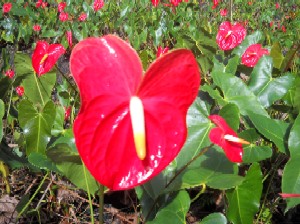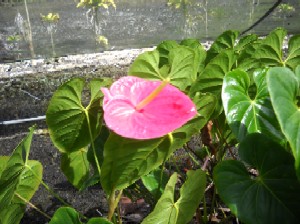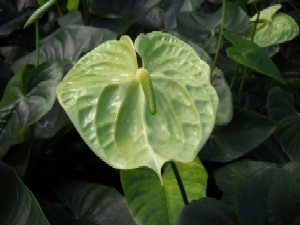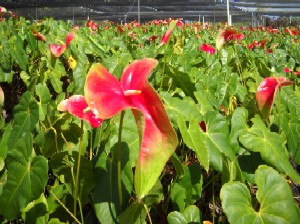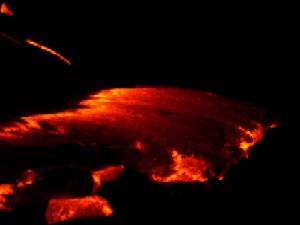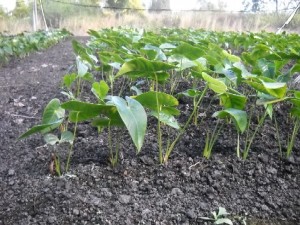Anthurium Flowers of Hawaii
Anthurium flowers aren’t native to Hawaii, but they have certainly made themselves at home here in our lush tropical paradise.
If you would like to buy anthurium flowers from Hawaii, please be sure to check out our anthurium flower catalog. But now, let’s get back to our story.
Anthurium Flowers: Where Do They Come From?
Before they decided to make a home for themselves among the volcanoes and beaches of Hawaii, anthuriums grew in the hot, humid rain forests of Central and South America. There they grew undisturbed for thousands of years.
Then one day in 1876 a man who would later become the head gardener of Paris, Edouard Andre, spotted a beautiful plant, while on a botanical expedition in the rain forests of Columbia.
It turned out that this plant was an anthurium plant.
How Did The Anthurium Get To Hawaii?
Edouard sent this magnificent specimen back to Europe and it first landed in Belgium. From Belgium, it was taken to the Kew Royal Botanic Gardens in England, (which claims to be one of the largest gardens in the world, containing one eighth of all the known plant species in the entire world.)
In 1889, Samuel Mills Damon, Hawaii’s Minister of Finance (and also Hawaii’s fourth largest landowner at the time) brought the first anthurium to Hawaii from England. He planted it in the gardens of his estate.
How The Anthurium Flower Developed in Hawaii
In the 1930s and 40s anthuriums spread from Damon’s estate all around Hawaii. Hobbyists began growing anthurium flowers in gardens and even their backyards, under Hapu’u tree ferns or tangerine trees.
The year 1936 was an important year for Hawaii’s anthurium flower industry. This was the year that a red anthurium which came to be known as the Ozaki was found in the garden O. Ozaki in the town of Hilo on the Big Island of Hawaii. At one point in time, the Ozaki was one of the best selling varieties of anthurium flowers from Hawaii.
1946 marked the discovery of a beautiful orange anthurium called the Nitta. It came from the garden of Asako Nitta and some say that is bears a striking resemblance to the original anthurium discovered by Edouard Andre.
In 1950, Haruyuki Kamemoto, returned to Hawaii after finishing his PhD at Cornell and launches the University of Hawaii‘s anthurium research program, which, as we will soon see, has a significant impact on the anthurium industry in Hawaii.
(As a side note, not only did Kamemoto have a huge impact on Hawaii’s anthurium industry, he also made major contributions to Hawaii’s orchid industry as well.)
1963 was another important year. It marked the release of the Uniwai white anthurium and the Marian Seefurth pink anthurium from the University of Hawaii. The Marian Seefurth anthurium was named after the wife of a man who made a very generous donation to the UH to fund anthurium research. These varieties were the first in a string of new anthurium varieties released by the University of Hawaii.
The Mauna Kea anthurium was released in 1977 by the UH. It is a large white and green obake anthurium variety.
In 1988, the first anthurium to be patented, the Starlight, which was developed by Calvin Hayashi, is introduced to Hawaii’s anthurium industry. It produces red flowers that are mottled with white specks. Mr. Hayashi also developed a dazzling green anthurium called the Midori.
In 1993, the University of Hawaii’s first patented anthurium is released. It is the Kalapana anthurium, which is a red and green obake anthurium flower. It is named after the magnificent black sand beach that was destroyed by a lava flow from the Kilauea Volcano.
Anthuriums on Amazon
Here are a few interesting anthurium related items that I saw on Amazon. I get a small commission from Amazon if you buy something through one of my links. The commission helps me to keep this site running and it doesn’t cost you any extra because Amazon already factors it into the price of all of its products.
Anthurium Scherzerianum Plant Care
Scherzerianum (or Pig-Tail Anthurium) are a beautiful breed of anthurium plant that produces red, orange or pink flowers. What sets them apart from Andraeanum is their spadix. They have a curly spadix, rather than a straight one like Andraeanum. Since they are closely related to Andraeanum, Anthurium Scherzerianum Plant Care is really not very different than what is required for Andraeanum.
I suppose that the main difference between the species is that Scherzerianum is a bit better adapted as a houseplant so they are in fact a little easier to care for.
Temperature
The ideal temperature for it is 80 degrees. Ideally, it should not be exposed to temperatures below 60 degrees or above 90 degrees. Temperatures below 60 degrees will hinder growth and flowering, while temperatures above 90 degrees can cause damage to flowers and leaves. Freezing temperatures are to be avoided at all costs, since exposure to frost can be deadly.
Light
Bright, indirect sunlight is best. But direct exposure to midday sun can burn leaves and foliage, so make sure that it is never exposed to strong, direct sunlight. If your plant is near a window with direct sun, cover the window with a thin, filmy curtain to block a portion of the light. If your plant receives too little light, it may stop flowering. A tell-tale sign of insufficient light is a plant that produces a lot of dark green leaves and no flowers.
Potting Soil
Any loose, well drained soil will work well. If you have access to volcanic cinder, you can use it. If not, you can use a mix that has bark, moss and perlite. The key is to make sure that your potting soil drains well. Excessive moisture can cause root rot and other problems that may harm your plant.
Watering
Water your plant regularly, but make sure that the water drains out of the pot quickly. In the rainforest, these plants grow up the side of trees. Despite receiving daily water from rain, their roots are never soaked in water because the water drips down the side of the tree and away from their roots. Since your plant is in a pot, you need to make sure that all of the water drains out of the pot and the potting soil dries slightly, but not completely, before watering again.
Humidity
Humidity should be high, but not excessive. Somewhere around 70 to 80% is ideal. Any higher and fungal issues may occur. Down to 50% is generally fine. But you may want to mist the leaves once and a while. Mist the leaves in the morning and make sure that they dry by the evening to prevent fungal problems. If they don’t dry by the evening, this means that your humidity is more than enough and you don’t need to mist your plants. At this level of humidity good air circulation is essential to prevent the growth of fungus.
Anthurium Plant Problems
Many anthurium plant problems are easily avoidable and can be avoided by following a few simple anthurium care guidelines. Today I am going to talk about the problems that can be caused by giving them too much or too little water, exposing them to incorrect temperature ranges, and providing them too much or too little light.
Watering
Anthurium plants like water but they also like it when their roots can breathe. Water them regularly or they will be stunted or even die. But water them too much and they will experience root rot, have their leaves turn yellow and eventually die.
There are two secrets to watering them.
The first secret involves a lot more work than the second, so it is more prone to resulting in over or under watering. It is to always check the potting media before watering. If it’s soaked, then wait a while before watering. You want to water your plant before the media becomes bone dry and after it is no longer soggy. There should still be a hint of moisture or the roots of your plant will go into shock, and the roots will struggle to absorb water again.
The second secret is to do what we do on the farm, which is to grow them in volcanic cinder. Cinder is a highly porous media that drains exceptionally well. So if you forget to water your plant it probably isn’t the media for you. But it drains so well that your plant can be watered daily without root rot as long as you remember to empty the drip tray that your pot is sitting in. You don’t even have to check if it is soggy; you just wake up in the morning and water your plant. By the following morning the cinder will have dried sufficiently for you to water your plant again, without fear of root rot.
Temperature
Anthuriums like most people don’t like extreme temperatures. Freezing weather will kill them. Hot weather, above 90 degrees, can burn their leaves and damage their flowers. Cold weather below 50 degrees can reduce their rate of growth and cause their leaves to turn yellow. They prefer to be kept at temperatures between 70 to 90 degrees.
Light
Excessive direct sunlight will burn the leaves and flowers of your plant. When left in strong sun, the leaves of your plant will start to turn yellow. If you don’t heed this warning sign, next the leaves will turn brown and die. Anthuriums can tolerate a fair amount of shade, since in their native habitat, they live under the highly shaded canopy of a rain forest, but too little light can cause stunted growth and a decrease in flower production. So if this starts to happen to your plant, give it a little more light.

